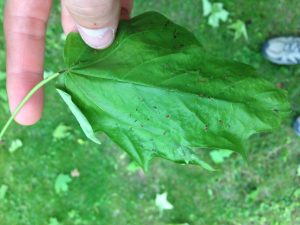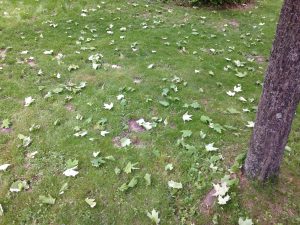
Maple petiole borer damage close up. Photo by Kyle Young.
Maple petiole borer has been active in the northwest. This exotic insect’s larvae cause tunneling damage to leaf petioles, leading to spring leaf drop in sugar maple.
Landowners have reported leaves falling from their sugar maple for no apparent reason. While a first glance of the problem might look similar to maple anthracnose, which is a foliar disease that can also cause premature leaf drop in spring, and has also been notably active this year (see this month’s article on maple anthracnose), a closer inspection of characteristics on fallen leaves points to maple petiole borer instead.

Maple petiole borer damage far away. Photo by Kyle Young.
The first clue is fallen leaves with mostly uncurled, healthy green tissue with little to no sign of dark, necrotic lesions. Another clue is leaf blades that break off close to the leaf base, with typically only a darkened and shriveled petiole stub remaining. An examination of the petiole interior may reveal larvae and their tunnels.
Even during outbreaks maple petiole borer rarely causes leaf loss in excess of 30% on individual trees and therefore has little effect on tree health. Chemical control is not recommended, but removing and destroying fallen petioles within 7-10 days after they fall may reduce maple petiole borer populations the following year.
Written by Paul Cigan, forest health specialist, Hayward (Paul.Cigan@Wisconsin.gov), 715-416-4920.
